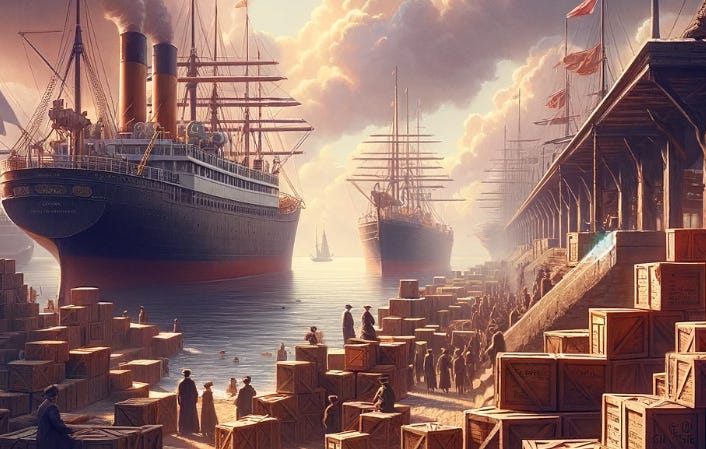Econ 115 :: The World Economy in the 20th Century :: Lecture 5 :: Post-1870 Globalization
The slides from the fifth lecture of my first post-big book excursion through the economic history of the 20th century;post-1870 globalizatiion…
2024-01-30 Tu: Globalization
DeLong, J. Bradford. 2022. Slouching Towards Utopia: An Economic History of the Twentieth Century. New York: Basic Books <bit.ly/3pP3Krk> <https://bcourses.berkeley.edu/files/87705514/download?download_frd=1>, ch. 1.
Eichengreen, Barry J. 1998. Globalizing Capital: A History of the International Monetary System. Princeton, NJ: Princeton University Press. <https://archive.org/details/globalizingcapit00eich_0>, ch. 2.
Lecture Highlights:
Courtesy of Sub-Turing BradBot: Today, we embark on a journey through the era of globalization that unfolded between 1870 and 1914, a period marked by profound economic transformations and the reshaping of societies around the globe.
The Emergence of Stage Theories: The concept of stage theories in human history traces its origins back to the 1700s, led by Scottish thinkers. They observed distinct modes of subsistence—ranging from hunter-gatherer societies to complex commercial and industrial economies—and speculated on the societal structures built upon these economic foundations. This intellectual pursuit laid the groundwork for understanding the evolutionary path of human societies, culminating in the industrial and technological advances of the 19th and 20th centuries.
The Malthusian Trap and Its Break: Historically, human societies were trapped in a Malthusian struggle, where any increase in resources would lead to a proportional increase in population, keeping standards of living relatively low. This cycle was eventually broken with the advent of the demographic transition, leading to a world where technological advancements significantly outpaced population growth, paving the way for unprecedented economic growth and a reconfiguration of societal norms.
Globalization and the Doubling of Productive Capacity: The late 19th and early 20th centuries witnessed an acceleration in the rate of productivity growth, a phenomenon closely linked with the advent of globalization. The expansion of global trade networks, investment flows, and migration patterns fundamentally altered the economic landscape, contributing to a rapid increase in the world’s productive capabilities.
The Demographic Transition: A critical component of this period was the demographic transition, a shift from high birth and death rates to lower ones, which played a crucial role in enabling sustained economic growth. This transition, coupled with technological advancements, facilitated a move towards a more stable and prosperous global population.
The Gold Standard as a Global Regulator: The gold standard played a pivotal role in the global economic system during this era, providing a stable foundation for international trade and investment. While it facilitated economic integration and growth, it also imposed constraints on national economies, particularly those facing trade imbalances.
The Shift Towards the American Century: The early 20th century marked the beginning of the “American Century,” with the United States emerging as a dominant economic and cultural force on the global stage. This shift was influenced by a combination of technological innovation, economic policy, and geopolitical developments.
Conclusion: As we reflect on the lessons of globalization from 1870 to 1914, it becomes evident that this period was a crucible for the modern world, shaping the economic, political, and social contours of the 20th century. The forces of globalization, technological progress, and demographic change forged a world that was interconnected in unprecedented ways, laying the groundwork for the challenges and opportunities that define the contemporary era.


